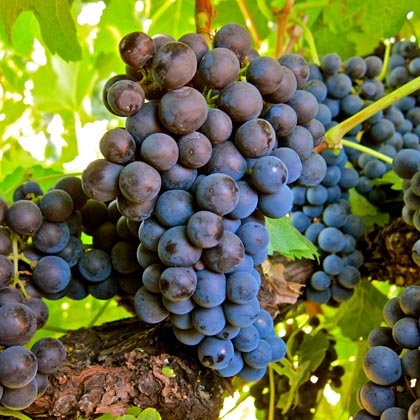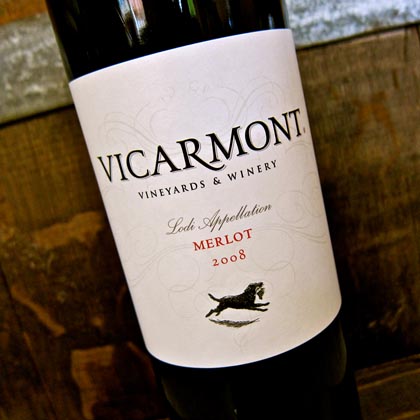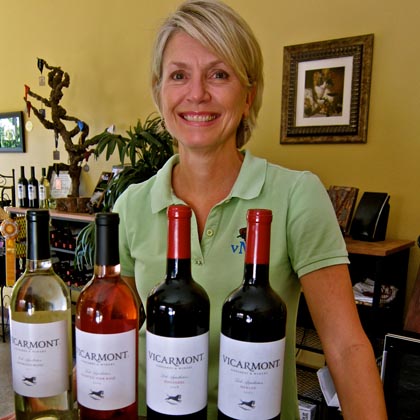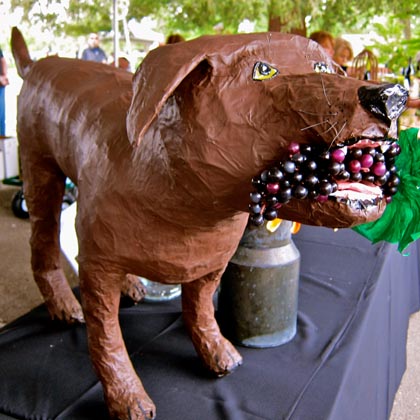Letters from Lodi
An insightful and objective look at viticulture and winemaking from the Lodi
Appellation and the growers and vintners behind these crafts. Told from the
perspective of multi-award winning wine journalist, Randy Caparoso.
Vicarmont keeps the Merlot faith
Ripening Merlot in Vicarmont's Locust Tree Vineyard (09/14/11)
Still plenty of respect for Merlot among Lodi winegrowers…
Bart: If fairytales have taught us anything, first wives are the best and second wives are terrible.
Homer: Just the opposite of real life…
– The Simpsons
Vicarmont grower/proprietor, Vic Mettler
How soon we forget the finest things. Not too long ago, Merlot was the go-to wine for the majority of America’s red wine drinkers – what Chardonnay was to Bridget Jones, white Russians to the Big Lebowski. Then this varietal suffered the indignity of being disparaged in the movie Sideways (2004); and soon after, became decidedly unhip. Yet good grapes are good grapes, and Merlot still makes terrific wine: full bodied, juicy rich red wines appreciated for exactly those qualities, no matter what anyone named Miles, or a Willie or a Sam, might say.
No one has ever had to tell Vic Mettler what is plain as day: that Merlot is a grape of peerless pedigree. Twenty years ago Mettler committed his 40 acre Locust Tree Vineyard to Merlot, on a property belonging to his side of the multi-strand Mettler family since the turn of the last century. Sticking with Merlot, since 2005 Mettler’s bottlings under his Vicarmont Vineyards label have been consistent medal winners.
The 2008 Vicarmont Lodi Merlot ($20), for instance, is a paragon of plump, plush, black cherry and cedar box sensations, with plenty of long, sinewy, sexy leg showing through velvet textures, happily landing on a chocolate bar. As a plainer speaking vigneron, Mettler simply says, “I like the soft, smooth, fruit focused style of wine that Merlot gives you, and the way it allows the taste of Lodi fruit to come through.” Fair enough – exactly what everyone once adored in this grape.
LangeTwins Vineyards winemaker David Akiyoshi knows a thing or two about Merlot; recently taking the time to recollect the fortunes of the grape, going back to his prior career as longtime winemaker for Woodbridge by Robert Mondavi. “Thirty years ago there was virtually no Merlot to speak of here in Lodi. But once we got started, the versatility of the region began to prove itself.” Today, Lodi crushes over 90,000 tons of Merlot each year. That’s about 30% of California’s entire crush; and for the record, more than five times more than all of Napa County. Adds Akiyoshi, “you can grow almost any high quality wine grape when you have high quality climate and soils. Merlot grows well in Lodi for the same reason Zinfandel does well – quality always finds a home.”
Yet how many of Lodi’s 75 or so specialty wineries even produce a varietal Merlot? Apart from Vicarmont, surprisingly few. Understandably, Zinfandel rules the roost here in Lodi (red zin, of course – almost as strangely, none of the boutique producers put out a “White Zinfandel”). Zinfandel is, after all, Lodi’s heritage grape; the AVA’s enduring link to the families that originally settled into this fertile Delta region during the post-Gold Rush heyday of the nineteenth century (whose descendents, as it were, continue to farm most of Lodi’s vineyards, and own the majority of the region’s existing wineries).
Vicarmont's Carrie Mettler
Zinfandel enthusiasts have become legion because, undoubtedly, the grape appeals to the hedonism in us all. They say that Pinot Noir appeals to sensualists, and Cabernet Sauvignon to the effete aesthetes. Merlot, on the other hand, has never been associated with any such affectations. In its heyday, Merlot was never a grape requiring a doctorate to decipher, yet has never taken a backseat to, say, Zinfandel or Pinot Noir when it comes to pure, unadulterated drinkability. A well made Merlot is never something you think about: it’s a feel thing.
To capture that feel, according to Mettler, it’s a matter it’s a matter of reducing crop to bring the fruit/canopy ratios on vertical trellises into better balance; and then being patient, waiting for “that grassy flavor in the grape to disappear, and the taste of Merlot to come out.” Ironstone Vineyards winemaker Steve Millier — who crafts as pure and luscious a Merlot as anyone — concurs, saying that “Merlot needs to ripen sufficiently to have that deliciousness… there’s nothing wrong with being soft, round and juicy.”
When you do find an ultra-premium quality Merlot like that, it’s reason to celebrate. Even so, says Grands Amis Winery winemaker Roger Nicholas, “I often have to twist people’s arms to get them to taste our Merlot.” And Nicholas makes a dandy: a velvety smooth and bright Merlot of sweet disposition, despite its own leggy grip and husky sensuality. “The grape has lost so much of its cachet, but it doesn’t mean it’s lost any of the qualities that made it popular in the first place. Of course, once I get them to try it, they always love it.”
One thing for sure, you really never can keep a good grape down – especially in Lodi!
Vicarmont's Monty (the third part of "Vic-Carrie-Monty")




